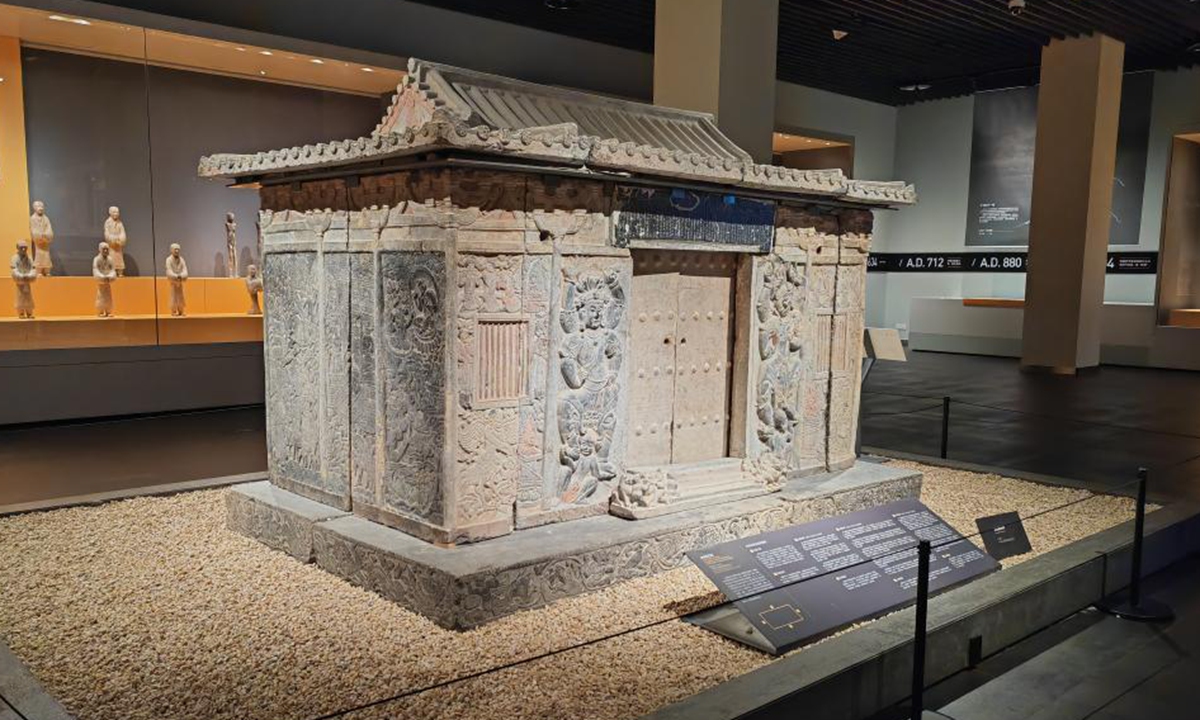
A stone sarcophagus exhibited in the Xi'an Museum exposed to the laser pointer Photo: Xinhua News Agency
A viral social media post revealed that a tour guide used a laser pointer while explaining details of a relic at the Xi'an Museum in Shaanxi Province,
mk raising concerns about potential damage to the artifact.
"Flash photography emits intense bursts of light that can accelerate artifact aging and shorten their lifespan. While occasional exposure has less impact, we strongly advise against using intense light sources, especially laser pointers," a staff member, surnamed Liu, from Xi'an Museum, told the Global Times on Monday. "The laser beam is highly concentrated, and if directed at an artifact for an extended period, it may cause irreversible damage."
According to Liu, the Xi'an Museum strictly prohibits the use of flash photography, laser pointers and flashlights inside exhibition halls. Security screenings are also conducted at the entrance to ensure visitors do not bring prohibited items that could harm artifacts.
"We will strengthen supervision, improve security screening procedures, and ensure that similar incidents do not happen again. Additionally, we will also enhance education for staff and visitors to ensure compliance with artifact preservation regulations," she added.
The artifact exposed to the laser pointer was a stone sarcophagus from the tomb of Shi Jun. Dating back to the Northern Zhou Dynasty (557-581), it was discovered in 2003 in a noble's tomb in Xi'an's Weiyang district. The sarcophagus features inscriptions in Sogdian and Chinese, along with carvings that blend multiple cultural elements, making it valuable for studying cultural and commercial exchanges along the Silk Road, according to the Xinhua News Agency.
Liu Zheng, a member of the Chinese Society of Cultural Relics, told the Global Times that "While brief exposure to laser pointers may not immediately damage stone artifacts, they are susceptible to temperature fluctuations. Large temperature differences could cause surface detachment or even cracks in the material."
Meanwhile, artifacts like silk, paintings and ancient manuscripts are much more vulnerable to light exposure. Flash photography is widely banned in museums to prevent damages from strong light, infrared and ultraviolet rays, which could accelerate oxidation, fading, and degradation of these delicate materials, Liu Zheng explained.
The incident has sparked heated online discussions about the importance of banning laser pointers and other light sources in museums.
"The damage may not be immediately visible, but over time, it will definitely have an impact. When we visited the Xi'an Museum and the Shaanxi History Museum, we didn't even dare to turn on our phone flashlights," read a comment on China's X-like platform Sina Weibo.
Another Weibo user echoed this comment, writing, "Ever heard of the saying 'constant dripping wears away a stone'?"
In fact, many museums across China have already posted rules prohibiting the use of flashlights, laser pointers and other strong light sources in exhibition spaces. The National Museum of China's website explicitly states that flash photography, selfie sticks and tripod-mounted cameras are not allowed without prior approval.

